How Climate Change and Land Use/Land Cover Change Affect Domestic Water Vulnerability in Yangambi Watersheds (D. R. Congo)
Abstract
1. Introduction
2. Materials and Methods
2.1. Study Site
2.2. Methods
2.2.1. Data Collection
- I.
- Composition indices: dense forest (DF), perturbed forest (PF), crop land (CL), grass land (GL), and bare soil and residential (BSR).
- II.
- Configuration indices: edge density (ED), patch density (PD), great patch area (GPA), mean patch area (MPA) and number of patches for the different composition indices (Table 1).
2.2.2. Data Processing and Statistical Analysis
3. Results
3.1. Watershed Typologies in Yangambi
3.1.1. Morphometric Characteristics
3.1.2. LULC Patterns Related to Anthropization in the Different Watersheds in Yangambi
3.2. Water Quality in Yangambi for the Main Domestic Water Supplies in the Different Watersheds
3.3. Relationship between the Physicochemical Quality of Stream Water Based on Indices of Landscape Configuration and Composition in Watersheds
3.4. Analysis of Domestic Water Resources Vulnerability to Climate Change
3.4.1. Analysis of the Yangambi Weather Station Climatic Parameters
3.4.2. Availability, Accessibility, Use and Management Capacity of Water Resources in Yangambi
4. Discussion
4.1. LULC Dynamics in the Yangambi Watersheds
4.2. Water Quality in Yangambi According to WHO Standards
4.3. Physicochemical Parameters of River Waters’ Nexus Landscape Parameters in the Yangambi
4.4. Water Vulnerability and Climate Change in Yangambi
5. Conclusions and Recommendations
Author Contributions
Funding
Acknowledgments
Conflicts of Interest
References
- Uuemaa, E.; Roosaare, J.; Mander, Ü. Scale dependence of landscape metrics and their indicatory value for nutrient and organic matter losses from catchments. Ecol. Indic. 2005, 5, 350–369. [Google Scholar] [CrossRef]
- Zhu, X.J.; Yu, G.R.; Wang, Q.F.; Hu, Z.M.; Zheng, H.; Li, S.G.; Sun, X.M.; Zhang, Y.P.; Yan, J.H.; Wang, H.M.; et al. Spatial variability of water use efficiency in China’s terrestrial ecosystems. Glob. Planet. Chang. 2015, 129, 37–44. [Google Scholar] [CrossRef]
- FAO. Global Forest Resources Assessment 2010; Food and Agricultural Organization: Rome, Italy, 2010; ISBN 978-92-5-106654-6. [Google Scholar]
- Brummett, R.; Tanania, C.; Pandi, A.; Ladel, J.; Munzini, Y.; Russell, A.; Stiassny, M.; Thieme, M.; White, S.; Davies, D. Ressources en Eau et Biens et Services Liés à L’écosystème Forestier; Les forêts du bassin du Congo—Etats des forêts 2008; Office des publications de l’Union européenne: Luxembourg, 2008; pp. 145–161. Available online: http://carpe.umd.edu/ (accessed on 15 December 2020).
- de Wasseige, C.; Tadoum, M.; Eba’a Atyi, R.; Doumenge, C. Les forêts du Bassin du Congo—Forêts et Changements Climatiques; Weyrich: Neufchâteau Belgium, 2015; 127 p, ISBN 978-2-87489-356-8. [Google Scholar]
- Partow, H. Water Issues in the Democratic Republic of the Congo: Challenges and Opportunities; UNEP: Nairobi, Kenya, 2011. [Google Scholar]
- Mayaux, P.; Pekel, J.F.; Desclée, B.; Donnay, F.; Lupi, A.; Achard, F.; Clerici, M.; Bodart, C.; Brink, A.; Nasi, R.; et al. State and evolution of the African rainforests between 1990 and 2010. Philos. Trans. R. Soc. B Biol. Sci. 2013, 368, 20120300. [Google Scholar] [CrossRef]
- Chishugi, J.; Xu, Y. Water supply and sanitation in the Democratic Republic of the Congo. In Sustainable Groundwater Resources in Africa; CRC Press: Cap Town, South Africa, 2009; pp. 205–220. [Google Scholar] [CrossRef]
- IMF. Issues in Managing Water Challenges and Policy Instruments: Regional Perspectives and Case Studies; Tech Companion Note; IMF: Washington, DC, USA, 2015; pp. 1–22. [Google Scholar]
- Dieng, M. L’eau en Afrique, Les Paradoxes D’une Ressource Très Convoitée. 2011, p. 3. Available online: https://www.idrc.ca/sites/default/files/sp/Documents%20FR/ict4d-article-water-dieng-fr.pdf (accessed on 15 December 2020).
- Barten, P.K.; Ernst, C.E. Land conservation and watershed management for source protection. Am. Water Work Assoc. 2004, 96, 121–135. [Google Scholar] [CrossRef]
- Sonwa, D.J.; Farikou, M.O.; Martial, G.; Félix, F.L. Living under a fluctuating climate and a drying Congo basin. Sustainability 2020, 12, 2936. [Google Scholar] [CrossRef]
- Garcia-Chevesich, P.A.; Neary, D.G.; Scott, D.F.; Benyon, T.R. Forest Management and the Impact on Water Resources: A Review of 13 Countries; UNESCO: Paris, France, 2017. Available online: https://www.fs.usda.gov/treesearch/pubs/54133 (accessed on 17 December 2020).
- Mikwa, N.; Masimo, K.; Kahindo, J.; Nshimba, H. Analyse prospective de la déforestation estimée par télédétection dans la réserve de biosphère de Yangambi. Int. J. Innov. Sci. Res. 2016, 24, 236–254. [Google Scholar]
- Tyukavina, A.; Hansen, M.C.; Potapov, P.; Parker, D.; Okpa, C.; Stehman, S.V.; Kommareddy, I.; Turubanova, S. Congo Basin forest loss dominated by increasing smallholder clearing. Sci. Adv. 2018, 4, eaat2993. [Google Scholar] [CrossRef]
- Sood, A.; Ritter, W.F. Developing a framework to measure watershed sustainability by using hydrological/water quality model. Water Res. Prot. 2011, 3, 788–804. [Google Scholar] [CrossRef][Green Version]
- Babur, E.; Kara, Ö. The Turkish Journal of Occupational/Environmental Medicine and Safety. Turkish J. Occup. Environ. Med. Saf. 2004, 1, 4711. Available online: http://dergipark.gov.tr/download/article-file/324842 (accessed on 15 December 2020).
- Stolton, S.; Dudley, N. Managing forests for cleaner water for urban populations. Unasylva 2007, 58, 39–43. [Google Scholar]
- Center for International Forestry Research. Améliorer l’accès à l’eau et à l’éléctricité—Diagnostic des Potentialités Solaires et Options Hydrauliques Dans le Paysage de Yangambi; Center for International Forestry Research: Bogor, Indonesia, 2015; p. 4. [Google Scholar]
- Sullivan, C. Calculating a water poverty index. World Dev. 2002, 30, 1195–1210. [Google Scholar] [CrossRef]
- Manandhar, S.; Pandey, V.P.; Kazama, F. Application of water poverty index (WPI) in Nepalese context: A case study of Kali Gandaki River Basin (KGRB). Water Res. Manag. 2012, 26, 89–107. [Google Scholar] [CrossRef]
- Mohymont, B.; Demarée, G.R. Courbes intensité-durée-fréquence des précipitations à Yangambi, Congo, au moyen de différents modèles de type Montana. Hydrol. Sci. J. 2006, 51, 239–253. [Google Scholar] [CrossRef]
- American Public Health Association, American Water Works Association, Water Environment Federation. Standard Methods for the Examination of Water and Wastewater, 22nd ed.; American Public Health Association, American Water Works Association, Water Environment Federation: Washington, DC, USA, 2012; Volume 5, p. 186. [Google Scholar]
- WHO. Guidelines for Drinking-Water Quality: Fourth Edition Incorporating the First Addendum; World Health Organization: Geneva, Switzerland, 2017. [Google Scholar]
- Brandt, J.S.; Nolte, C.; Agrawal, A. Deforestation and timber production in Congo after implementation of sustainable management policy: A response to Karsenty et al. (2017). Land Use Policy 2018, 77, 375–378. [Google Scholar] [CrossRef]
- Orelien, F. Etude de la Qualite de L’eau Destinee a la Consommation Humaine Dans le Sous-Bassin Versant de Ravine Diable (Anse-A-Veau). Master’s Thesis, Université de Liège, Liège, Belgique, 2017. Available online: http://hdl.handle.net/2268.2/3245 (accessed on 15 December 2020).
- Mapulanga, A.M.; Naito, H. Effect of deforestation on access to clean drinking water. Proc. Natl. Acad. Sci. USA 2019, 116, 8249–8254. [Google Scholar] [CrossRef] [PubMed]
- Xiao, H.; Ji, W. Relating landscape characteristics to non-point source pollution in mine waste-located watersheds using geospatial techniques. J. Environ. Manag. 2007, 82, 111–119. [Google Scholar] [CrossRef] [PubMed]
- Pratt, B.; Chang, H. Effects of land cover, topography, and built structure on seasonal water quality at multiple spatial scales. J. Hazard. Mater. 2012, 209–210, 48–58. [Google Scholar] [CrossRef]
- Jones, A.; Breuning-Madsen, H.; Brossard, M.; Dampha, A.; Deckers, J.; Dewitte, O.; Gallali, T.; Hallett, S.; Jones, R.; Kilasara, M.; et al. Soil Atlas of Africa; European Commission, Publications Office of the European Union: Luxembourg, 2013; 176p, ISBN 978-92-79-26715-4B. [Google Scholar]
- Kombele, B. Caractéristiques pédologiques comparées de termitières sous forêts primaires du plateau de Yangambi en cuvette centrale congolaise. Tropicultura 2002, 20, 76–82. [Google Scholar]
- CICOS. Schéma Directeur d’Aménagement et de Gestion Des Eaux de La CICOS (SDAGE); Commission Internationale du Bassin Congo-Oubangui-Sangha: Kinshasa, Democratic Republic of the Congo, 2016. [Google Scholar] [CrossRef]
- Garriga, R.G.; Foguet, A.P. Improved method to calculate a water poverty index at local scale. J. Environ. Eng. 2010, 136, 1287–1298. [Google Scholar] [CrossRef]
- Awojobi, O. Water poverty index: An apparatus for integrated water management in Nigeria. Int. J. Innov. Appl. Stud. 2014, 8, 591–599. [Google Scholar]
- Jemmali, H. Mesures de la pauvreté en eau: Analyse comparative et développement de l‘indice de pauvreté en eau. VertigO 2013, 13. [Google Scholar] [CrossRef]
- Aguilar, E.; Aziz Barry, A.; Brunet, M.; Ekang, L.; Fernandes, A.; Massoukina, M.; Mbah, J.; Mhanda, A.; Do Nascimento, D.J.; Peterson, T.C.; et al. Changes in temperature and precipitation extremes in western central Africa, Guinea Conakry, and Zimbabwe, 1955–2006. J. Geophys. Res. Atmos. 2009, 114, 1–11. [Google Scholar] [CrossRef]
- Jemmali, H. Water poverty in Africa: A review and synthesis of issues, potentials, and policy implications. Soc. Indic. Res. 2018, 136, 335–358. [Google Scholar] [CrossRef]
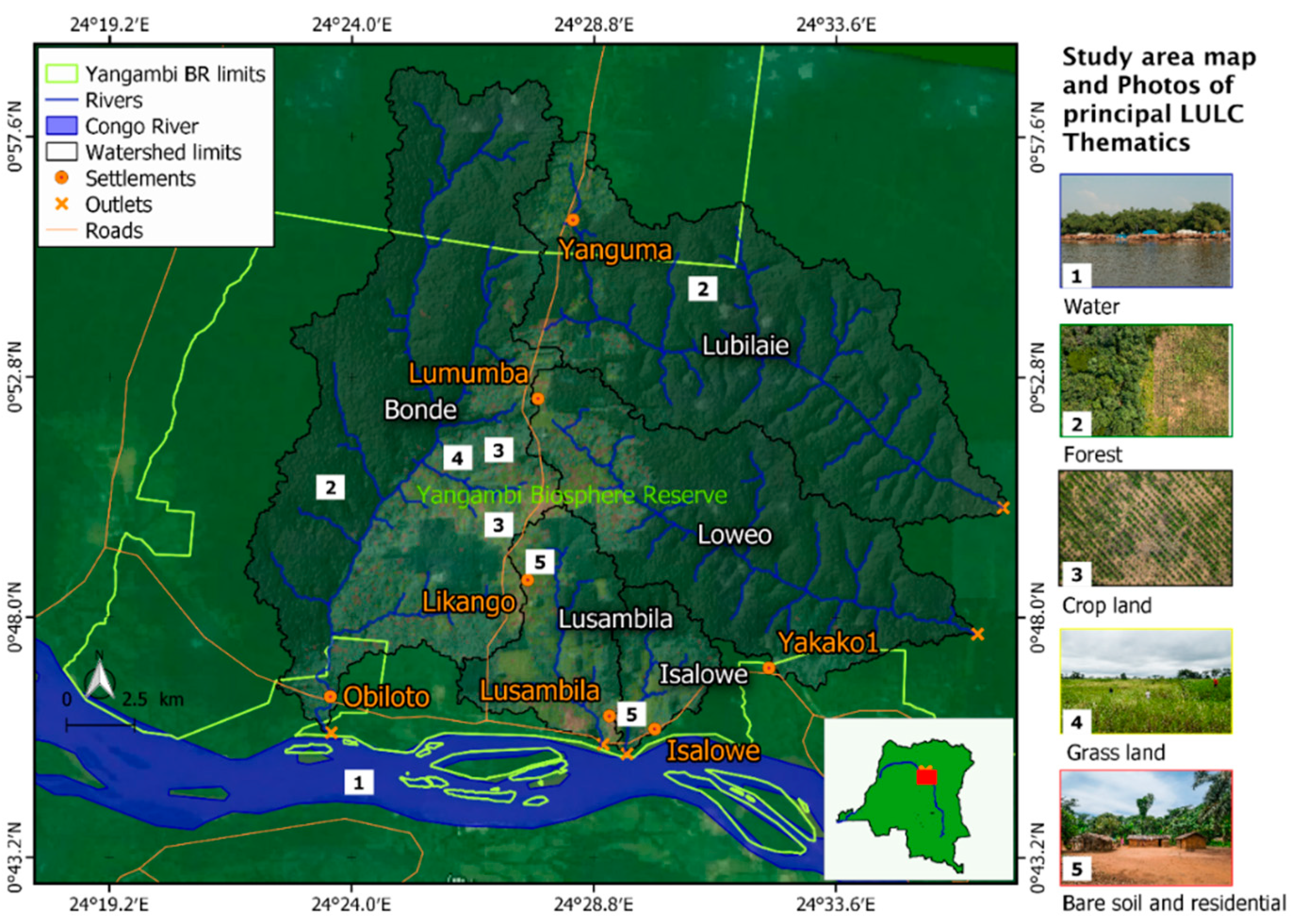
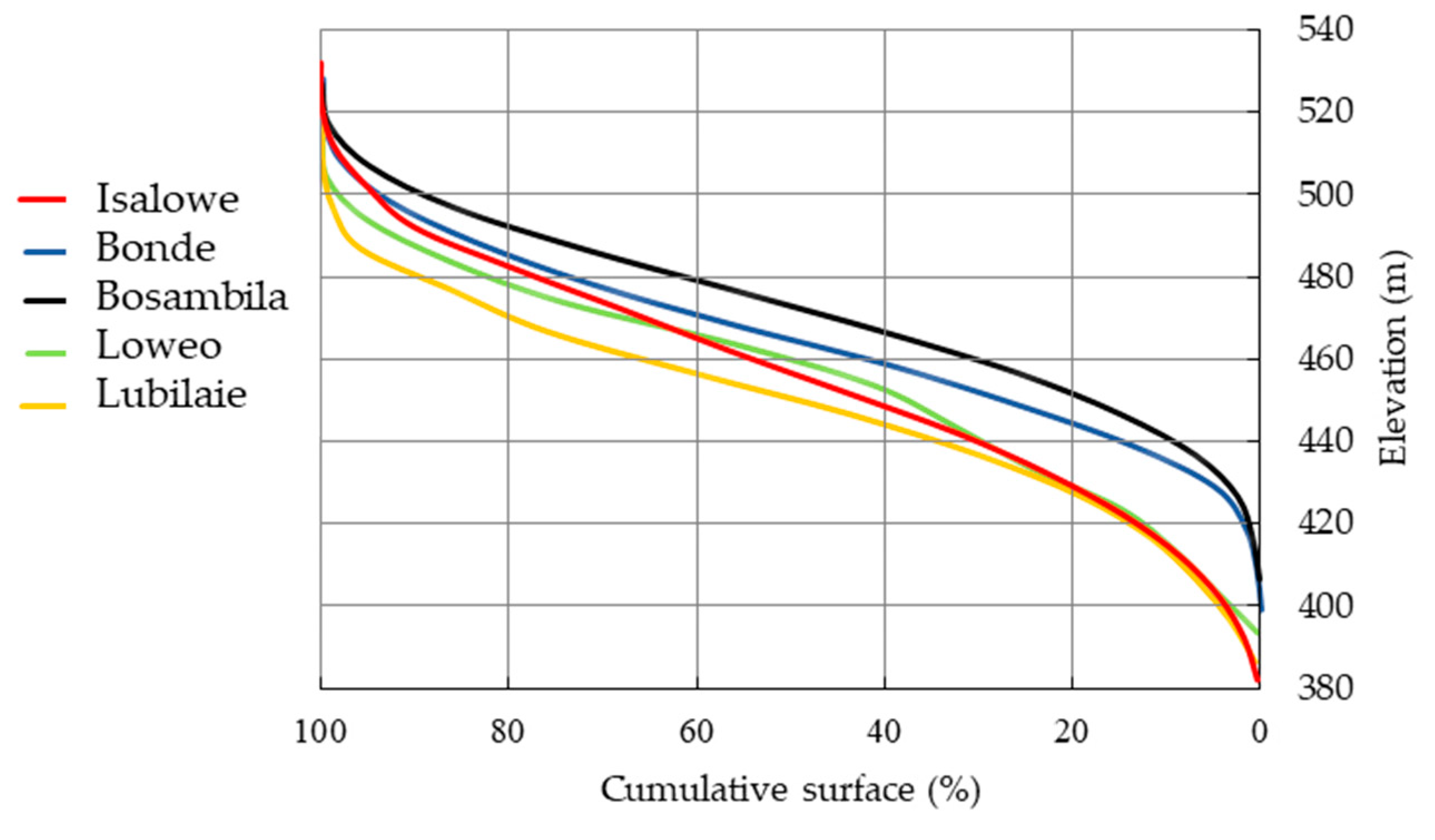
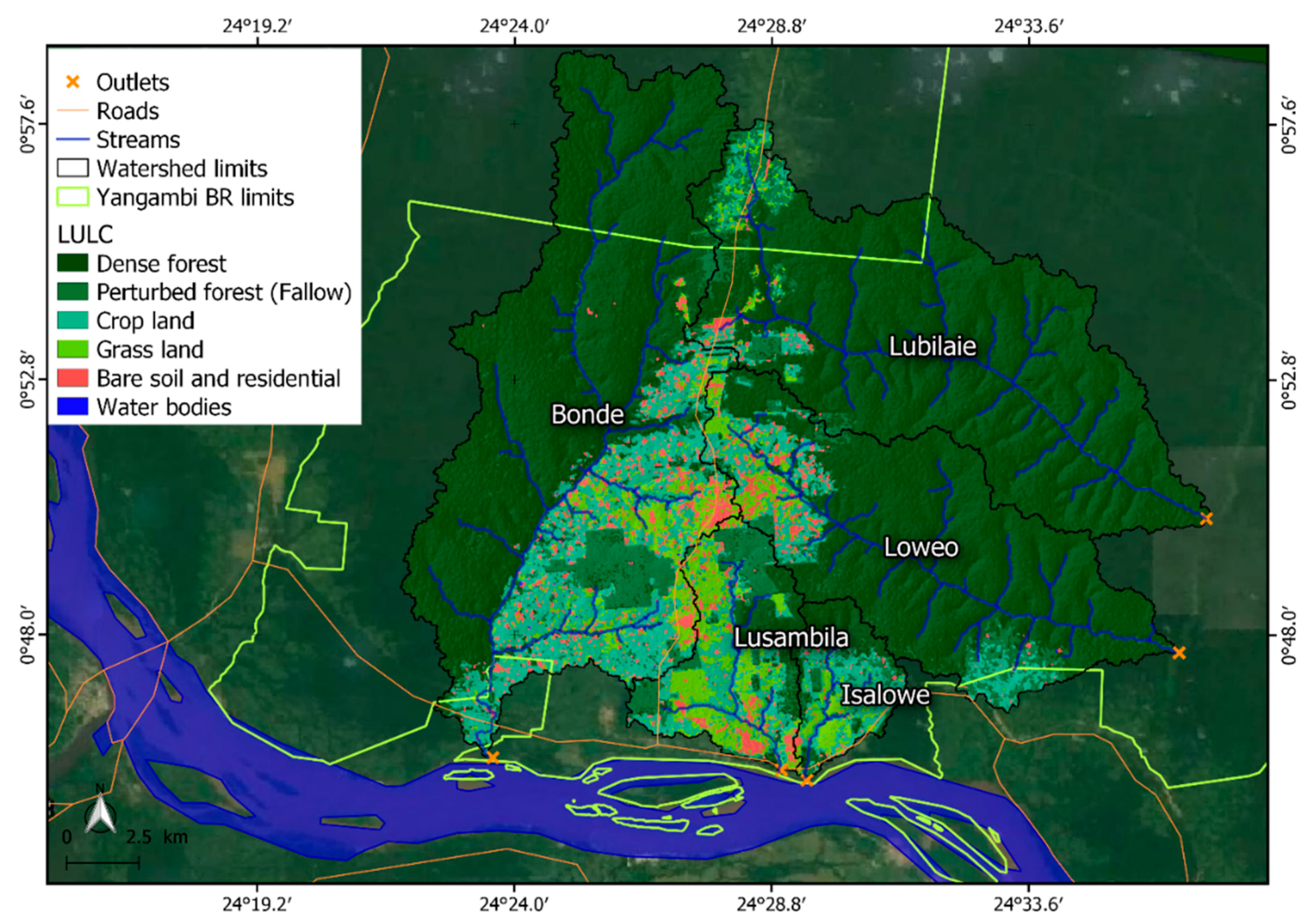
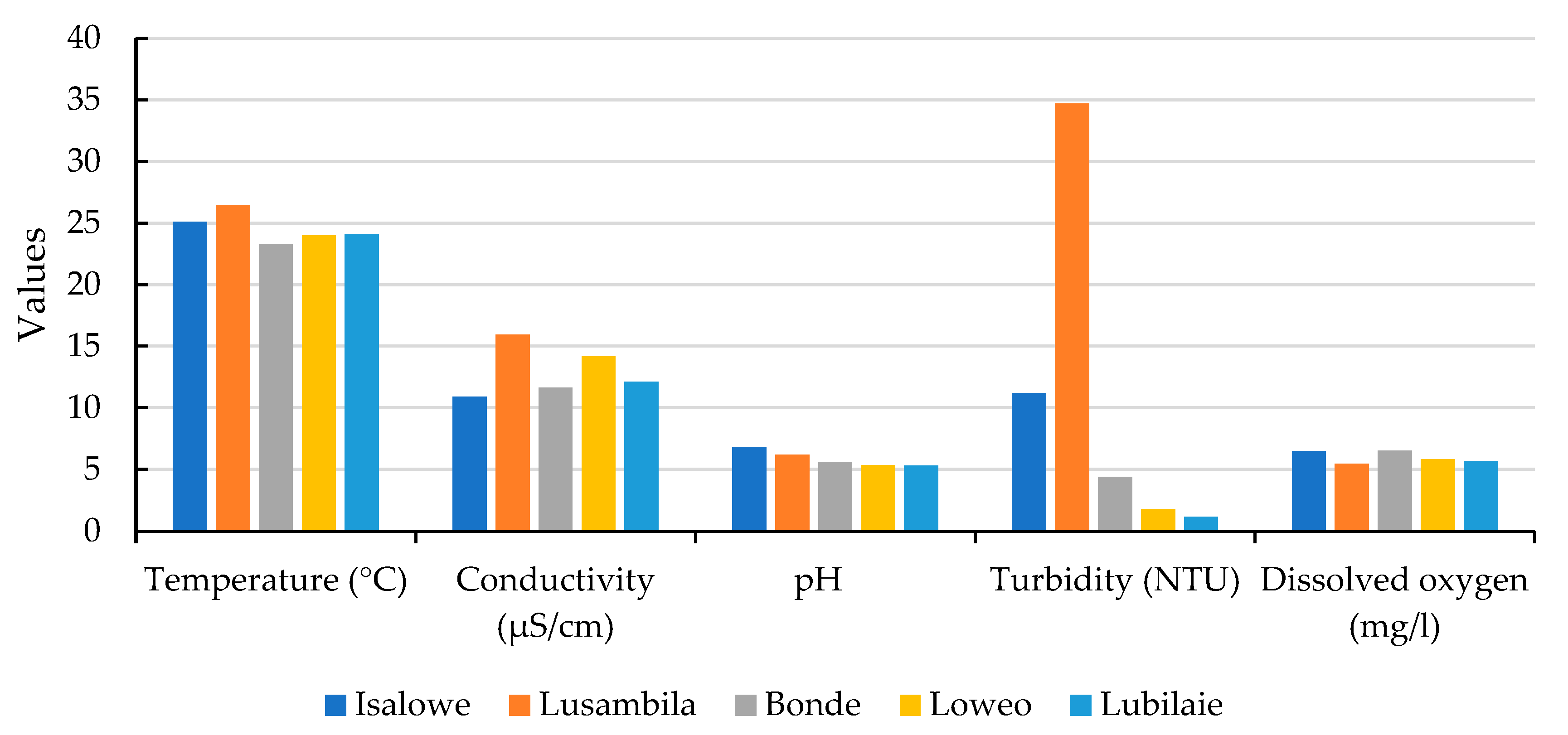
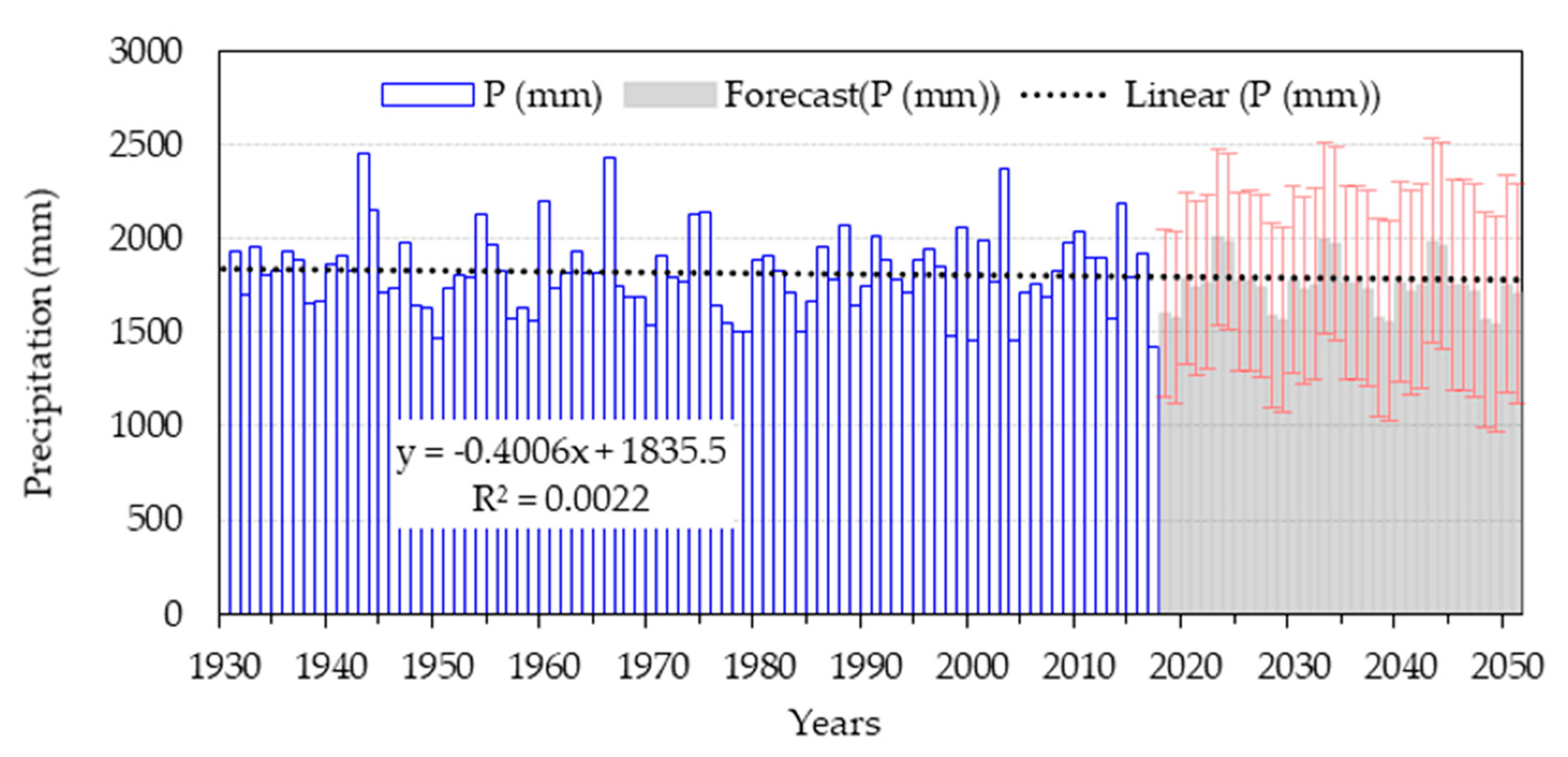
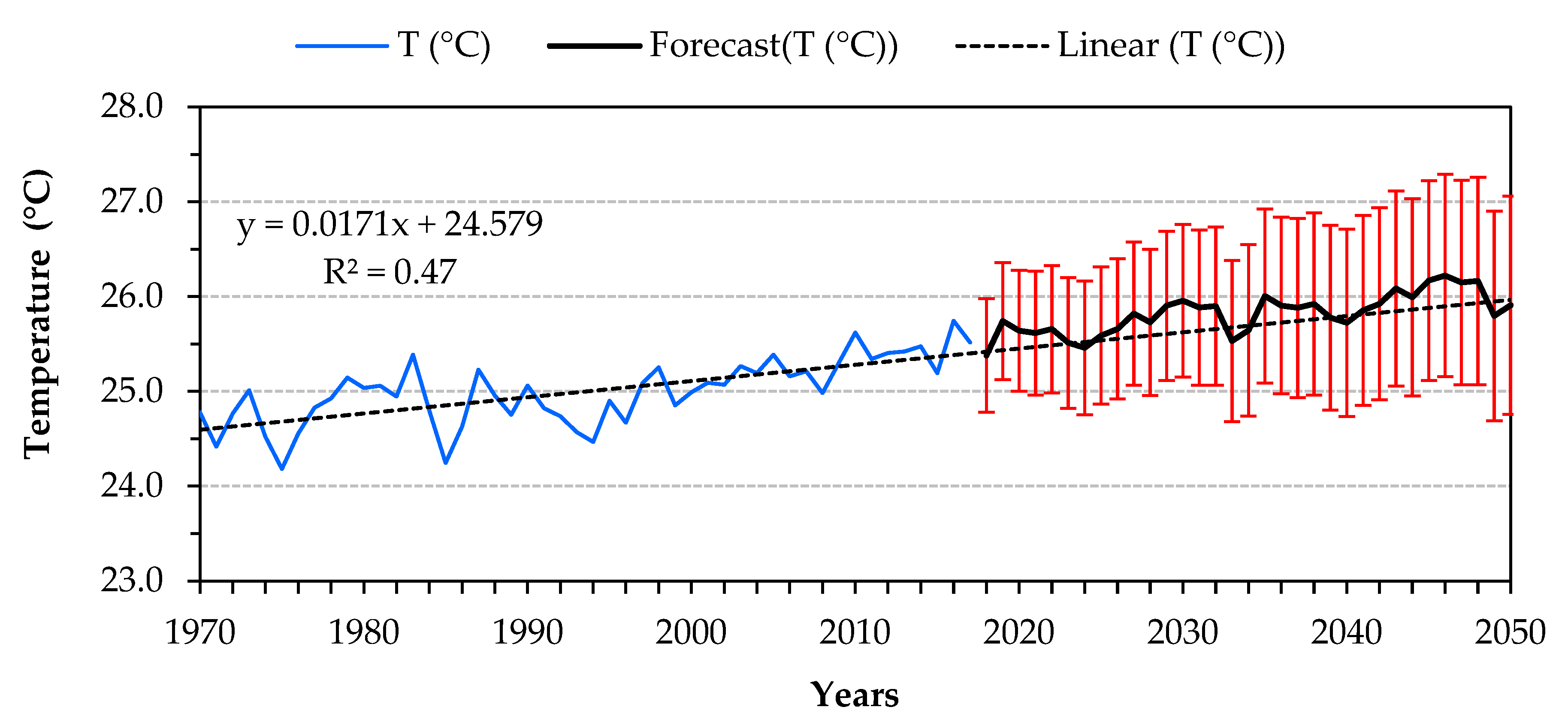
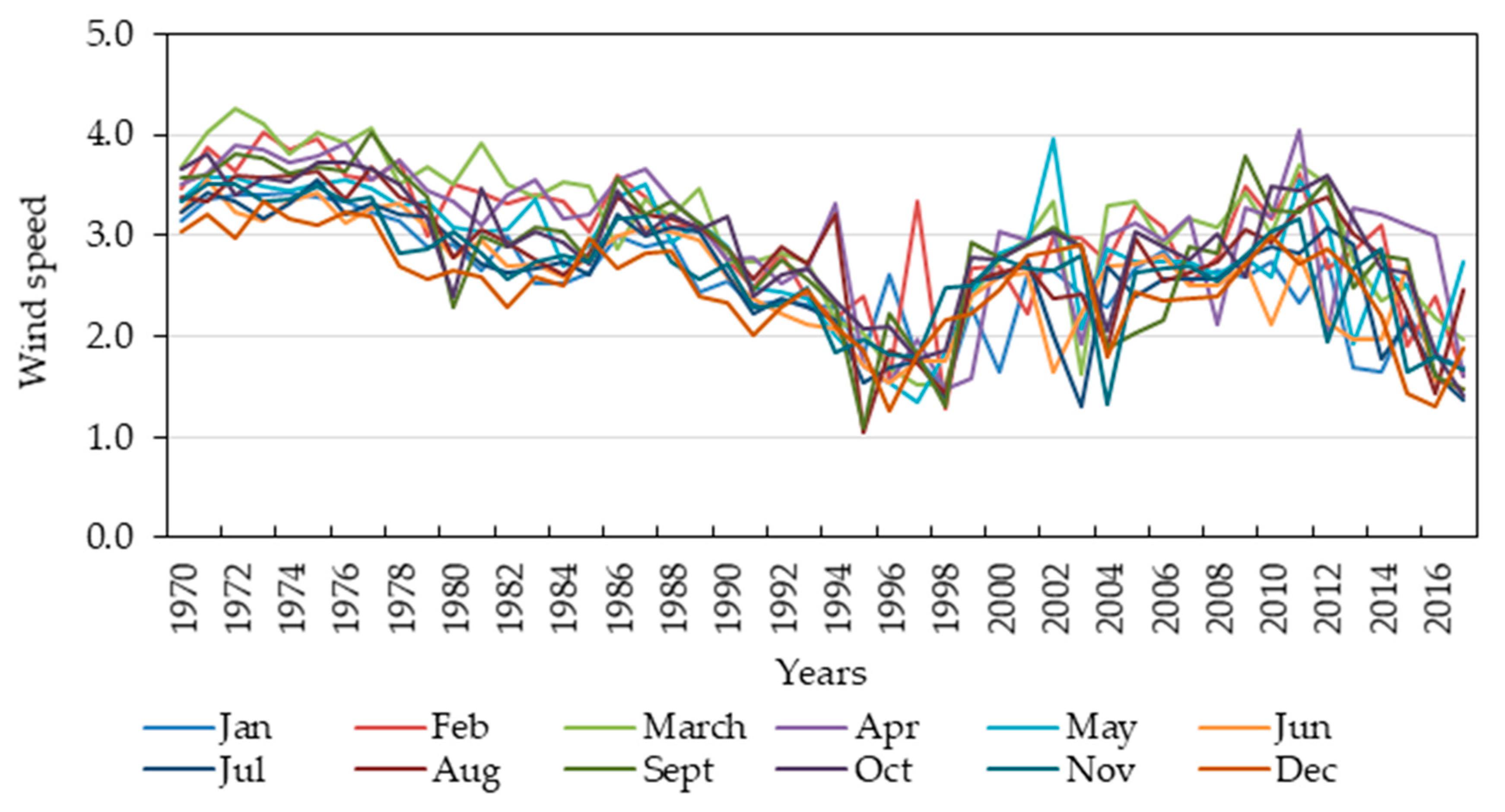
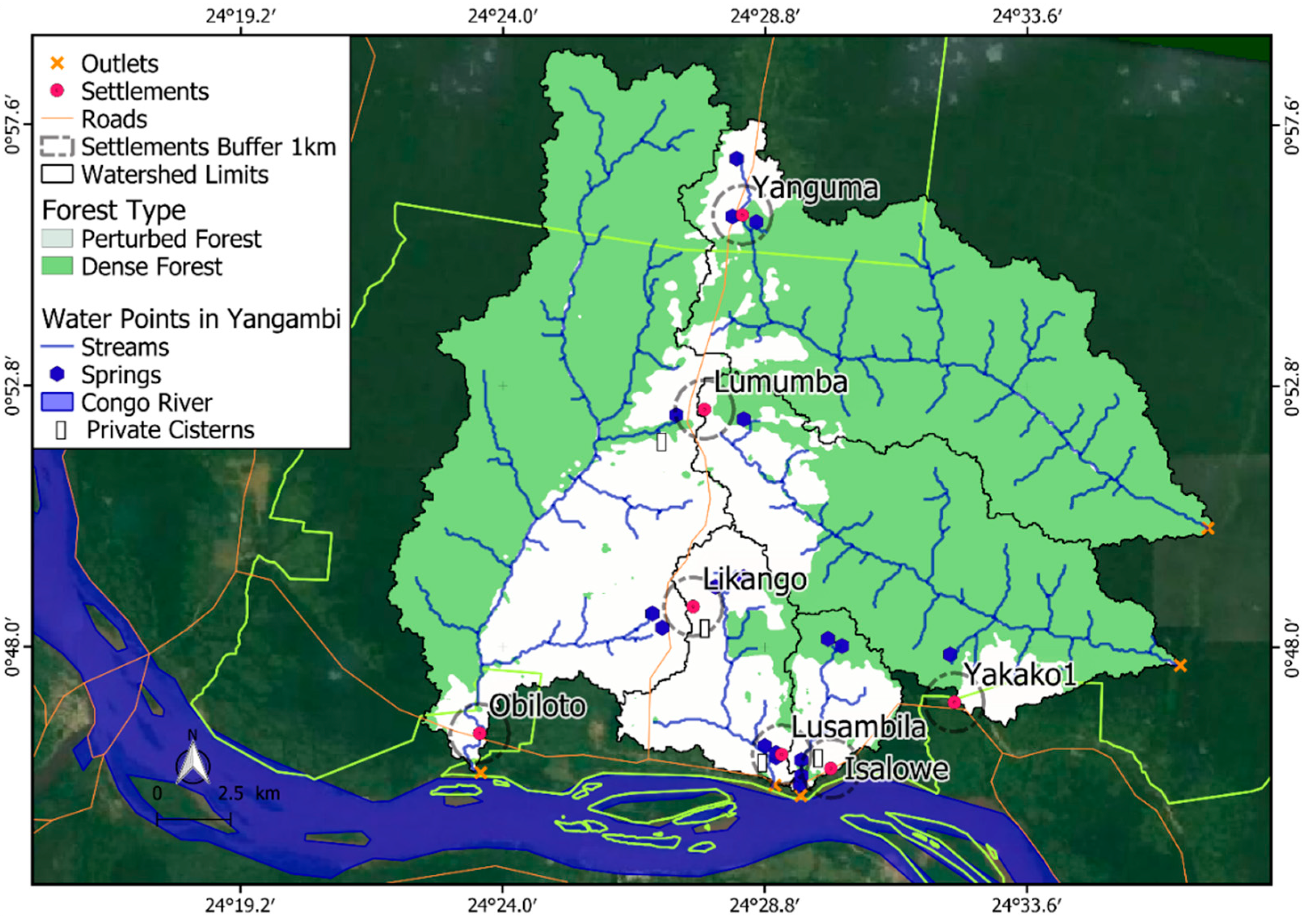
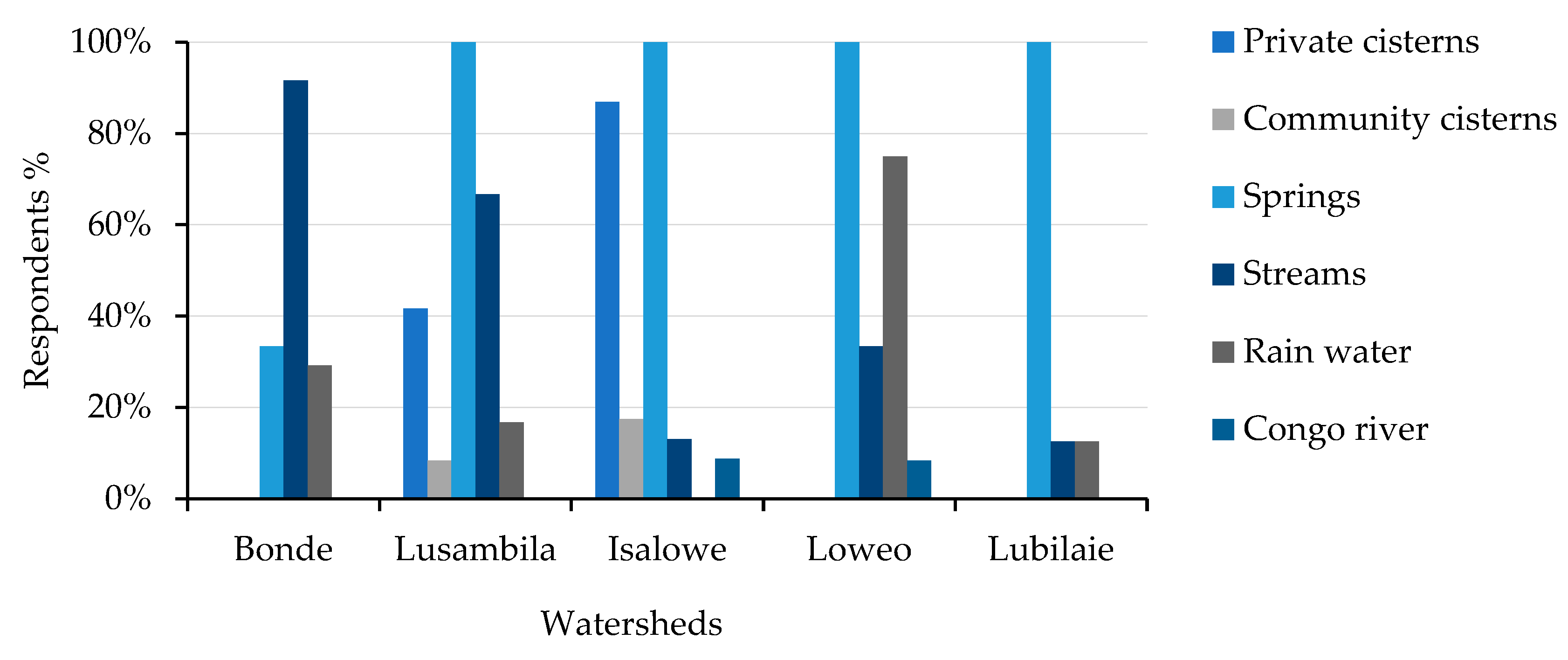
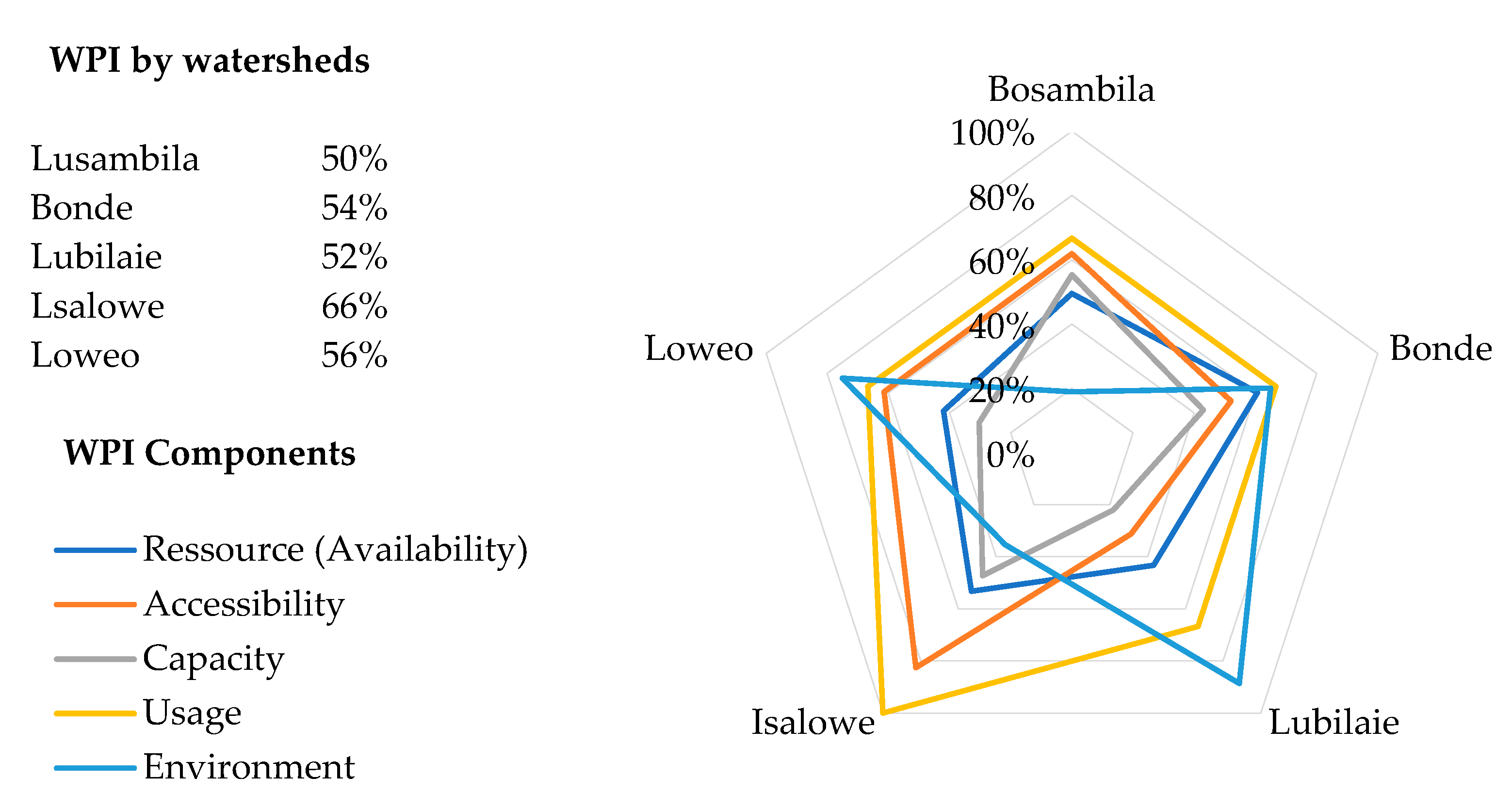
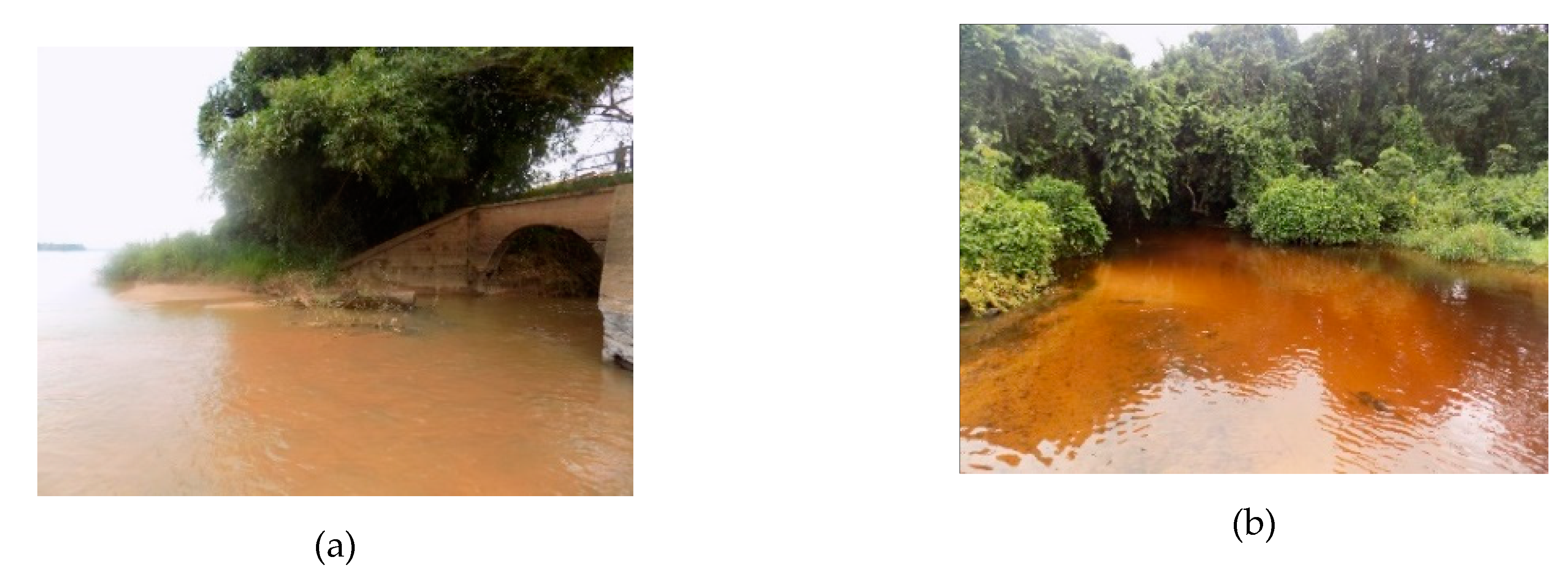

| Indices | Descriptions |
|---|---|
| Edge density | Total length of all edge segments per unit of area for the thematic class under consideration. |
| Patch density | Number of patches per unit of area, for a given thematic class |
| Great patch area | The area of the largest patch for a given thematic class |
| Mean patch area | Average area of patches for a given thematic class |
| Number of patches | Number of patches for a given theme class |
| Watersheds | Bonde | Loweo | Isalowe | Lusambila | Lubilaie |
|---|---|---|---|---|---|
| Surface area (km2) | 167.2 | 91.1 | 16.1 | 32.2 | 122.6 |
| Perimeter (km) | 117.2 | 75.1 | 26.5 | 41.8 | 93.5 |
| Gravellius Index (KG) | 2.5 | 2.2 | 1.8 | 2.1 | 2.4 |
| Average slope (%) | 7.8 | 7.3 | 9.2 | 7.6 | 8.0 |
| River length (km) | 90.7 | 56.3 | 9.0 | 17.7 | 73.5 |
| Drainage density (km/m2) | 0.5 | 0.6 | 0.6 | 0.6 | 0.6 |
| Altitude (m) | 458 | 468 | 448 | 450 | 478 |
| Equivalent rectangle: | |||||
| Length (km) | 56.1 | 35.3 | 12.0 | 19.4 | 44.3 |
| Width (km) | 3.0 | 2.6 | 1.3 | 1.7 | 2.8 |
| Water Points | Physicochemical Parameters | Lusambila | Bonde | Lubilaie | Isalowe | Loweo | Mean ± SD | WHO Standards |
|---|---|---|---|---|---|---|---|---|
| Rivers (n =7 water points) | Temperature (°C) | 26.4 | 23.3 | 24.05 | 25.1 | 24.5 | 24.8 ± 0.6 | <30 |
| Conductivity (µS/cm) | 15.92 | 11.64 | 12.095 | 10.88 | 12.36 | 29 ± 17.5 | <400 | |
| pH | 6.2 * | 5.6 * | 5.3 * | 6.8 | 5.5 * | 5.3 ± 0.5 | 6.5–8.5 | |
| Turbidity (NTU) | 34.7 * | 4.39 | 1.165 | 11.2 * | 1.46 | 2.3 ± 2.5 | <5 | |
| Dissolved oxygen (mg/L) | 5.44 | 6.53 | 5.665 | 6.48 | 4.67 | 5.6 ± 0.6 | - | |
| Improved springs (n =7 water points) | Temperature (°C) | 24.8 | 25.2 | - | 24.1 | - | 24.7 ± 0.6 | <30 |
| Conductivity (µS/cm) | 28.3 | 29.5 | - | 22.3 | - | 26.7 ± 3.9 | <400 | |
| pH | 5.2 * | 5.1 * | - | 5.3 | - | 5.2 ± 0.1 * | 6.5–8.5 | |
| Turbidity (NTU) | 0.2 | 0.3 | - | 1.2 | - | 0.56 ± 0.6 | < 5 | |
| Dissolved oxygen (mg/L) | 3.9 | 5.7 | - | 5 | - | 4.8 ± 0.9 | - | |
| Unimproved springs (n = 8 water points) | Temperature (°C) | 24.9 | 23.3 | 25.5 | 24.4 | 24.1 | 24.4 ± 0.8 | <30 |
| Conductivity (µS/cm) | 27.2 | 11.6 | 57.1 | 11.5 | 22.3 | 26 ± 18.7 | <400 | |
| pH | 5.3 * | 5.6 * | 4.6 * | 5.5 * | 5.3 * | 5.3 ± 0.4 | 6.5–8.5 | |
| Turbidity (NTU) | 1.9 | 4.4 | 2.1 | 10 * | 1.2 | 3.9 ± 3.6 | < 5 | |
| Dissolved oxygen (mg/L) | 6 | 6.5 | 6.5 | 6.1 | 5 | 6.02 ± 0.6 | - | |
| Cisterns (n = 44 water points) | Temperature (°C) | 24.3 | - | - | 25.8 | - | 25 ± 0.1 | <30 |
| Conductivity (µS/cm) | 42.2 | - | - | 80.4 | - | 61 ± 27 | <400 | |
| pH | 6.3 * | - | - | 6.0 * | - | 6.1 ± 0.2 | 6.5–8.5 | |
| Turbidity (NTU) | 14.8 * | - | - | 2.8 | - | 8.8 ± 8.5 | <5 | |
| Dissolved oxygen (mg/L) | 3.36 | - | - | 3.3 | - | 3.4 ± 0.01 | - |
| Parameters | Between Types of Water points | Between Watersheds | Between Springs in a Watershed | Between Rivers in a Watershed |
|---|---|---|---|---|
| Temperature | 0.162 | 0.0323 * | 0.296 | 0.121 |
| Conductivity | 0.687 | 0.00 *** | 0.116 | 0.0187 * |
| pH | 0.0297 * | 0.45 | 0.259 | 0.0734 |
| Turbidity | 0.73 | 0.392 | 0.872 | 0.00 *** |
| Dissolved oxygen | 0.512 | 0.0589 | 0.949 | 0.85 |
| Parameters | Temperature | Conductivity | pH | Turbidity | Dissolved Oxygen |
|---|---|---|---|---|---|
| Temperature | 1 | 0.58 | 0.66 | 0.92 * | −0.49 |
| Conductivity | 1 | −0.14 | 0.66 | 0.81 | |
| pH | 1 | 0.56 | 0.32 | ||
| Turbidity | 1 | 0.42 | |||
| Dissolved oxygen | 1 |
| Temperature | Conductivity | pH | Turbidity | Dissolved Oxygen | |
|---|---|---|---|---|---|
| DF_prop | −0.99 | ||||
| PF_prop | 0.95 | 0.96 | |||
| CL_prop | 0.96 | ||||
| GL_prop | 0.93 | 0.97 | |||
| ED_DF | 0.99 | ||||
| PD_DF | 0.95 | 0.94 | |||
| MPA_DF | −0.93 | ||||
| ED_PF | 0.97 | ||||
| PD_PF | 0.91 | ||||
| MPA_PF | 0.94 | ||||
| ED_CL | 0.96 | 0.91 | |||
| PD_CL | 0.97 | 0.89 | |||
| MPA_CL | 0.93 | ||||
| ED_GL | 0.91 | 0.99 | |||
| PD_GL | 0.93 | 0.95 | |||
| MPA_GL | 0.9 | 0.92 | |||
| ED_BSR | 0.93 | ||||
| MPA_BSR | 0.89 |
| Response Variable Y | Explicative Variable X | Fitted SLR Models | R2 | AIC |
|---|---|---|---|---|
| Temperature | Grass land | Y = 23.4 + 10.3902X | 0.8675 | 10.9 |
| PD_Crop land | Y = 22.94 + 53100X | 0.9362 | 7.2 | |
| ED_Grass land | Y = 23.2 + 418.0151X | 0.8198 | 12.4 | |
| MPA_Grass land | Y = 22.83 + 0.0000705X | 0.8151 | 12.5 | |
| Conductivity | MPA_Perturbed forest | Y = 8.7 + 0.0002183X | 0.8838 | 15.5 |
| pH | ED_Dense forest | Y = 4.2 + 464.98X | 0.9715 | 3.2 |
| PD_Dense forest | Y = 4.8 + 294000X | 0.9049 | 2.9 | |
| ED_Perturbed forest | Y = 4.4 + 399.02X | 0.9458 | 0.1 | |
| PD_Perturbed forest | Y = 4.79 + 152000X | 0.834 | 5.7 | |
| ED_Crop land | Y = 4.9411 + 180.3973X | 0.9268 | 1.6 | |
| PD_Grass land | Y = 4.71 + 311000X | 0.8617 | 4.8 | |
| MPA_BSR | Y = 7.65 − 0.000198X | 0.7965 | 6.7 | |
| Turbidity | Dense forest | Y = 4.3208 − 4.7445X | 0.9795 | 2.8 |
| MPA_Dense forest | Y = 2.94 − 0.00000405X | 0.8667 | 12.2 | |
| Dissolved oxygen | MPA_Crop land | Y = 5.26 + 0.0000112X | 0.8712 | 1.8 |
| Watershed | Distance (m) | Household Proportion by Water Point Distance | Water Consumed/ Person/Day | |
|---|---|---|---|---|
| Springs (%) | Rivers (%) | Quantity (L) | ||
| Bonde (n = 60 individuals) | <1000 | 12 | 84 | 33 |
| ≥1000 | 50 | 5 | ||
| ≥2000 | 38 | 11 | ||
| Lusambila (n = 30 individuals) | <1000 | 8 | 13 | 33 |
| ≥1000 | 50 | 63 | ||
| ≥2000 | 42 | 24 | ||
| Isalowe (n = 57 individuals) | ≤500 | 9 | - | 43 |
| <1000 | 4 | 67 | ||
| ≥1000 | 65 | - | ||
| ≥2000 | 22 | 33 | ||
| Loweo (n = 33 individuals) | ≥1000 | 50 | 50 | 31 |
| ≥2000 | 50 | 50 | ||
| Lubilaie (n = 20 individuals) | ≤500 | 75 | 100 | 29 |
| ≥1000 | 25 | - | ||
| Watersheds | Bonde (n = 60 Individuals) | Lusambila (n = 30 Individuals) | Isalowe (n = 57 Individuals) | Loweo (n = 33 Individuals) | Lubilaie (n = 20 Individuals) |
|---|---|---|---|---|---|
| Proportion of household by water treatment methods (%) | |||||
| No treatment | 96 | 83 | 39 | 92 | 87 |
| Filter | 4 | 17 | 39 | 0 | 0 |
| Boiling | 0 | 0 | 0 | 8 | 13 |
| Chlorine | 0 | 0 | 22 | 0 | 0 |
| Proportion of heads of households by level of education (%) | |||||
| Illiterate | 8 | 8 | 0 | 8 | 13 |
| Primary | 42 | 8 | 4 | 92 | 25 |
| Secondary | 50 | 67 | 91 | 0 | 63 |
| University | 0 | 17 | 4 | 0 | 0 |
| Household proportion by type of dwelling (%) | |||||
| Rural house | 67 | 17 | 0 | 83 | 100 |
| Durable house | 33 | 83 | 100 | 17 | 0 |
Publisher’s Note: MDPI stays neutral with regard to jurisdictional claims in published maps and institutional affiliations. |
© 2021 by the authors. Licensee MDPI, Basel, Switzerland. This article is an open access article distributed under the terms and conditions of the Creative Commons Attribution (CC BY) license (http://creativecommons.org/licenses/by/4.0/).
Share and Cite
Chishugi, D.U.; Sonwa, D.J.; Kahindo, J.-M.; Itunda, D.; Chishugi, J.B.; Félix, F.L.; Sahani, M. How Climate Change and Land Use/Land Cover Change Affect Domestic Water Vulnerability in Yangambi Watersheds (D. R. Congo). Land 2021, 10, 165. https://doi.org/10.3390/land10020165
Chishugi DU, Sonwa DJ, Kahindo J-M, Itunda D, Chishugi JB, Félix FL, Sahani M. How Climate Change and Land Use/Land Cover Change Affect Domestic Water Vulnerability in Yangambi Watersheds (D. R. Congo). Land. 2021; 10(2):165. https://doi.org/10.3390/land10020165
Chicago/Turabian StyleChishugi, David Ushindi, Denis Jean Sonwa, Jean-Marie Kahindo, Destin Itunda, Josué Bahati Chishugi, Fiyo Losembe Félix, and Muhindo Sahani. 2021. "How Climate Change and Land Use/Land Cover Change Affect Domestic Water Vulnerability in Yangambi Watersheds (D. R. Congo)" Land 10, no. 2: 165. https://doi.org/10.3390/land10020165
APA StyleChishugi, D. U., Sonwa, D. J., Kahindo, J.-M., Itunda, D., Chishugi, J. B., Félix, F. L., & Sahani, M. (2021). How Climate Change and Land Use/Land Cover Change Affect Domestic Water Vulnerability in Yangambi Watersheds (D. R. Congo). Land, 10(2), 165. https://doi.org/10.3390/land10020165






